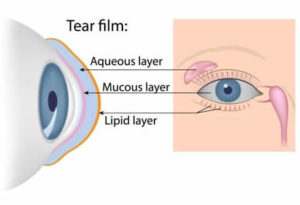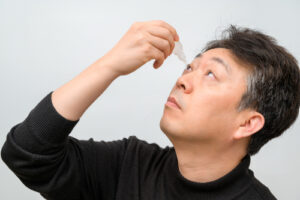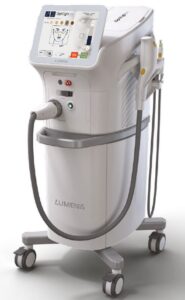Are your eyes dry, itchy, or causing you discomfort? These are often signs of a chronic eye condition called dry eye syndrome. If you have dry eyes, you’re not alone. Millions suffer from this chronic condition and its frustrating symptoms.
If you’re ready to feel better, Dr. Varanelli and our talented doctors at Simone Eye Center offer dry eye treatment options to improve your quality of life to reduce your symptoms and alleviate discomfort.
What is Dry Eye?

Dry eye syndrome is a chronic eye condition affecting tens of millions in the United States. It typically occurs if the eyes cannot produce enough tears, or the tears created are of poor quality.
Tears are an essential part of how your eyes stay healthy. They are responsible for keeping your eyes lubricated, nourished, and protected against particles, dust, or foreign objects.
If you are not producing enough tears or the tears in your eyes are not high enough in quality, this can lead to dry eye symptoms. Healthy tears come from the tear film.
The tear film has three components: oil, water, and mucus. If any of these components are missing or are out of sync with where they should be, it can cause frustrating dry eye symptoms.
How Do I Know if I Have Dry Eyes?
Common symptoms associated with dry eye syndrome include:

- Irritation
- Discomfort
- Finding it more challenging to wear contact lenses due to discomfort
- Dryness
- Blurry vision
- Light sensitivity
- Experiencing a foreign body sensation of having something in your eyes, even if nothing is there
- Noticing mucus in and around your eyes
- Experiencing a feeling of grit in your eyes
- Watery eyes
- Eye fatigue
- Frequent use of eye drops or artificial tears
If you have dry eyes, you may experience several symptoms or only one or two. However, the symptoms of dry eye syndrome are not exclusive to the eye condition, so see your eye doctor if you suspect you may have dry eyes.
Seeing your eye doctor will allow for proper diagnosis and treatment.
Our Dry Eye Center of Excellence at Simone Eye Center
Dr. Varanelli is an experienced eye doctor with a specialty in dry eyes and dry eye treatment. The Dry Eye Center of Excellence at Simone Eye Center and Dr. Varanelli provide comprehensive solutions for patients.
We use the most advanced and state-of-the-art technologies including OptiLightIPL, amniotic membranes, and more. Paired with the experience of Dr. Varanelli, Simone Eye Center can offer a patient-centric approach.
We tailor each patient treatment depending on the diagnosis, severity of symptoms, and other determining factors. Our eye care specialists may use several different treatment options to produce the best results, ensuring eyes feel rejuvenated and improve in functioning.
Treating dry eyes helps ensure patients can improve their quality of life and reduce their symptoms. With our dry eye center of excellence, Simone Eye Center makes each dry eye patient a priority through diagnosis and treatment that’s unique to them.
Dry Eye Treatments Available at Simone Eye Center
If you have dry eyes, the team at Simone Eye Center may recommend the following treatment options:
Prescription Medications

Your eye doctor may recommend starting with prescription medications to treat dry eyes. These are often in the form of eye drops and can help manage inflammation, increase tear production, and improve the quality of your tears.
Punctal Plugs
Another option that your eye doctor may recommend is punctal plugs. In both temporary and permanent options, punctal plugs are tiny plugs inserted into your tear ducts.
Using punctal plugs can help block tears from draining, ensuring your eyes stay well-lubricated with your own natural tears thus reducing dry eye symptoms.
IPL
IPL (Intense Pulsed Light Therapy) uses light pulses to treat dry eyes. IPL targets blood vessels that often lead to inflammation and dryness.
IPL helps stabilize the tear film, improving dry eye symptoms. IPL targets inflammation of the meibomian glands, which, when blocked or inflamed, can reduce your tear quality and increase how quickly tears evaporate from the eye.
Patients often require several sessions to improve meibomian gland function and reduce dry eye symptoms.
OptiLight

OptiLight is a treatment that uses IPL therapy to rejuvenate the meibomian glands. OptiLight promotes healthier meibomian glands to help produce a more stable, higher-quality tear film.
Improving the tear film prevents rapid evaporation of tears from the eyes. OptiLight also helps reduce eyelid and surface of the eye irritation, which helps improve dry eye symptoms like redness, irritation, and discomfort.
Patients typically require several sessions, depending on the severity of dry eye symptoms.
Autologous Serum Eye Drops
Autologous serum eye drops are eye drops custom-made from a patient’s blood serum and have been used in eyecare since 1984. These eye drops provide natural support to the eye’s surface because they contain essential nutrients and growth factors.
They are incredibly beneficial for patients with severe cases of dry eyes.
Amniotic Membranes
Amniotic membranes are grafts that can help heal the surface of the eye.
Amniotic membranes are derived from placental tissue which contain growth factors that promote tissue repair and help reduce eye inflammation. They are a beneficial treatment option and can be helpful if you’ve tried other dry eye treatments without success. This simple in-office procedure has shown significant improvements in our dry eye and ocular surface disease patients.
Dr. Varanelli is a leader in this field and has taught over a thousand eye doctors nationwide how to use and implement amniotic membranes in practice.
Do you have dry, itchy eyes that you can’t get relief from? Find out if it could be due to dry eye syndrome by requesting an appointment at Simone Eye Center in Warren, MI, today! Isn’t it time to do something about your dry eyes and feel better?


